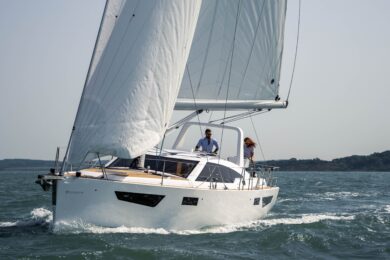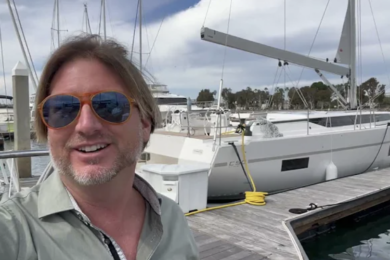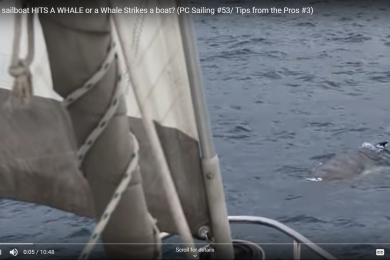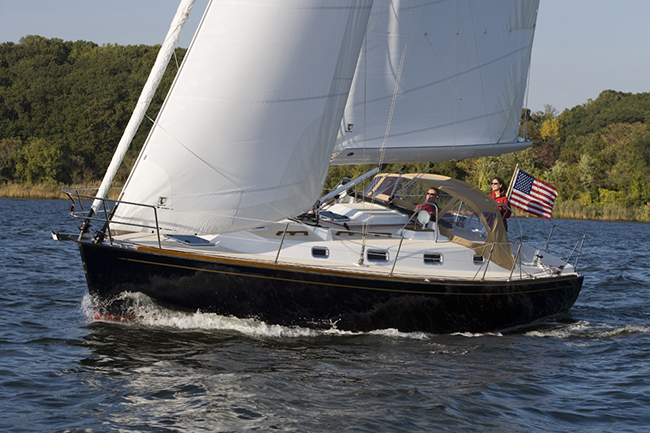This review is excerpted from the original that ran in BWS in 2005. The Tartan brand is now under new ownership and management by the principles of Seattle Yachts, which was a Tartan dealer before they bought the company. The 3400, rebranded at the 345, remains a great small cruising boat that is perfect for a couple who wants to downsize from a larger boat or a young family just getting started.
The brief for the 3400/345 was to create a boat that more than lives up to the Tartan name by providing her owners with a small cruiser that sails extremely well, makes few physical demands on the crew and makes the most of Tartan’s cutting edge boatbuilding technology.
The hull Jackett created for the 3400 has a 30-foot waterline and almost 12 feet of beam which translates into a boat that has a lot of interior volume for it’s size. The bow sections have been given a slight V-shape to prevent slamming when sailing to windward in a chop while the stern sections carry the beam well aft, which enhances reaching and running power and overall boat speed.
The rudder is positioned well aft where it will have the most leverage and has been designed to be a moderate balanced spade that grips the water even when heeled over and provides the helmsman with a very sure, almost sports car feel on the wheel.
The boat has three keel options to suit a wide range of sailing and cruising conditions. The standard deep fin, drawing six and a half feet, will maximize performance. For those who frequent sailing grounds with a lot of shallows – Southern New England, the Chesapeake, Florida’s West Coast, the Bahamas, etc. – Tartan offers two shoal draft options.
The Tartan Beavertail keel draws just under five feet; a fin with a large ballasted tail (that looks like a beaver’s tail), the keel reduces draft while providing the efficiencies of a bulb keel that has a positive “endplate” effect.
For those in really shoal areas, Tartan offers the tried-and-true keel/centerboard option that draws just under four feet with the board up and seven feet with the board down. Tartan has been building keel/ centerboard cruisers for 40 years and has the technology mastered.
The interesting thing about the various keel options is that the keels are interchangeable. Move the boat from the Chesapeake to the Pacific Northwest and you can swap out the keel/centerboard for the deep fin. This versatility will appeal to sailors who have to move their cruising bases and will be a real boon for boats on the brokerage market later on.
 The rig on the new 3400 combines sailing power with some very innovative thinking about sail handling and control. Both the mast and boom are carbon fiber (Awlgripped white) and set up with a simple two-spreader rig. The full-battened main is large and powerful; the mainsheet runs from mid-boom and the cabin-top traveler forward to the mast and then back to the cockpit.
The rig on the new 3400 combines sailing power with some very innovative thinking about sail handling and control. Both the mast and boom are carbon fiber (Awlgripped white) and set up with a simple two-spreader rig. The full-battened main is large and powerful; the mainsheet runs from mid-boom and the cabin-top traveler forward to the mast and then back to the cockpit.
An innovative “pocket boom,” which is V-shaped, makes lowering the big sail – with the aid of lazy jacks – extremely simple since the sail flakes itself in the boom and then can be covered with the in-boom sail cover. Before making the mooring or dropping the anchor, all you have to do is round up into the wind, let go the halyard and presto the main is down and under complete control.
The headsail system is equally innovative. The working 100- percent jib has been set up on a Harken roller-furling unit and a Harken track to be self-tacking. The sheet runs from the jib’s traveler up the front of the mast and then down to the deck and aft to the cockpit. To short tack the boat through a crowded harbor all you have to do is throw over the wheel, let the main and jib tack themselves and off you go on the new tack – no winch grinding required.
For reaching and downwind sailing, a reacher, also on a Harken roller, has been set up forward of the working jib. When it is time to fall off the wind all you have to do is roll up the jib, roll out the reacher and away you go with tons of horsepower flying in front of you. This system, called a Solent Rig in Europe, makes a lot of sense as it greatly simplifies sail handling while offering the right sails for every angle of wind. Tartan is unique among production builders (along with J/ Boats) for equipping their boats with carbon masts and booms as standard equipment. The decision to do so underscores the company’s efforts to lead the way with the best modern technology can offer. The weight savings in the mast translates into a stiffer boat that is less likely to roll or pitch in short seas. It also will be easier to tune and maintain than an aluminum spar.
Accommodations
 One of the decisions Jackett and the Tartan team had to make when they set out to design the new 3400 was how to meet the needs of their likely customers. They came down on the side of the new boat as a “couple’s cruiser” that would be a comfortable coastal cruiser (with occasional offshore runs) and a fine daysailer with a boatload of friends.
One of the decisions Jackett and the Tartan team had to make when they set out to design the new 3400 was how to meet the needs of their likely customers. They came down on the side of the new boat as a “couple’s cruiser” that would be a comfortable coastal cruiser (with occasional offshore runs) and a fine daysailer with a boatload of friends.
The emphasis, therefore, was on making the interior as spacious as possible while providing the owners with a large double berth in the quarter cabin and a large head, with a separate shower stall.
The guest cabin forward has a V-berth that is small by most standards, due in part to the fineness of the bow. The V-berth is a true double berth but two tall people will find themselves locking toes in the night, which might be a good thing. The forward cabin has a lot of storage and hanging space.
The main cabin makes use of the boat’s ample beam by pushing the settee benches outboard as far as possible. The drop leaf table runs down the centerline and with the leaves in place will accommodate four adults for a meal.
The galley has a two-burner Force 10 stove, a large sink and an ample icebox. Counters are Granicote (like Corian), which is easy to clean and maintain. A microwave oven and refrigeration are available options.
Navigators will like working at the chart table. The seat is comfortable and the table’s surface is wide enough for a standard chart kit. Electronics can be flush mounted above the chart table. The main electric panels are above the chart table and to starboard.
 Like most modern Tartans, polished cherry has been used through the boat for joinery and cabinets. Drawer fronts, doors and doorframes are solid wood, so they feel substantial and open and close with a satisfying thud. Door hardware and all latches are polished chrome and top-ofthe- line so you do not have to worry about a door, drawer or cabinet door flying open in a bouncy seaway.
Like most modern Tartans, polished cherry has been used through the boat for joinery and cabinets. Drawer fronts, doors and doorframes are solid wood, so they feel substantial and open and close with a satisfying thud. Door hardware and all latches are polished chrome and top-ofthe- line so you do not have to worry about a door, drawer or cabinet door flying open in a bouncy seaway.
Out of the box the 3400 is not set up as a passagemaker, but the boat is certainly capable of carrying her crew – most likely a couple – far and wide with the addition of tankage for extra fuel and water, an upgraded battery bank and charging system and all the sundry safety and navigational gear cruising boats require.
Read the full review here.
Visit the Tartan website here.















